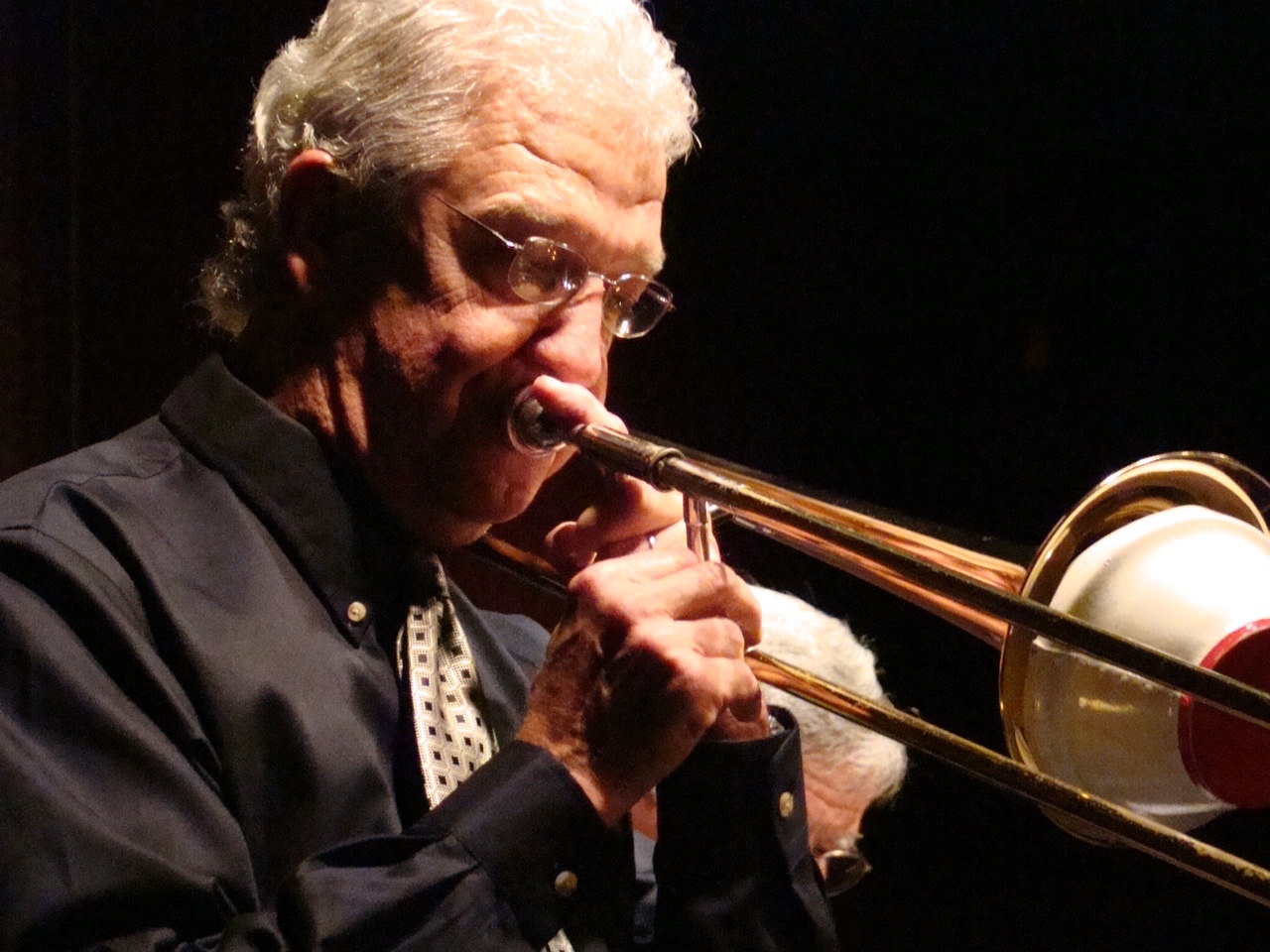My brother Doug is a jazz trombonist in Louisville, and after retiring from his day job a couple years ago he discovered that when you reach a certain age you can take classes at the University of Louisville free of charge. He’s been formally studying in the jazz program there ever since.
Yesterday’s Writer’s Almanac alerted me it was poet Robert Pinsky’s birthday, and that the U.S. poet laureate had played saxophone in his high school band. Pinsky said: “My first experience of art, or the joy in making art, was playing the horn at some high-school dance or bar mitzvah or wedding, looking at a roomful of people moving their bodies around in time to what I was doing […] The fact that it was my breath making a party out of things was miraculous to me, a physical pleasure.” I wondered if Doug felt the same way, and when I emailed him to ask, he sent back a quick no. “I’m not that deep.” His talented and lovely wife Shelley chimed in then, and her response was so interesting and thought-provoking I asked if I could share it here with my blog readers. I was delighted she said yes, and I think you’ll be, too.
by Shelley Finke
This is timely. It’s cool that a musician would notice the obviousness of the situation (people being inspired to dance by his music) and be moved by it. But Pinsky was really a poet, and that explains his depth, I think all would agree.
The more I hang with musicians, and my husband, especially, who also writes arrangements, I see they’re more like scientists than artists (in the commonly understood sense) because of the way everything has to work out mathematically and how the various notes have to get along with each other. That is what brings satisfaction to them.
And since Doug writes music, I see that it has to happen two times: first on the paper, and later in the performance. The listeners can tell him how it felt emotionally.
That brings me to the timeliness of your message. Last night Doug played his monthly thing with a local big band. They performed a brand new arrangement of Doug’s: The Summer Knows (the theme to the film Summer of ’42) with lyrics included for a female vocal. His primary concern was how it would come together as a unit, as a collection of sounds, not whether it would move people. So as a musician and arranger that’s what concerned him.
I think back to when he was inspired to write this chart a few months ago and how moved he was at the time by the lyrics being sung by Rosemary Clooney. He talked about that quite a bit to me. At that point he was a total listener. And he was deep. But then he started writing and the science of it began, and I imagine he left the job of moving the audience to the singer, which in this case was one of the most capable ladies in town.
It was a wonderful result! The singer knew how to sell it and the band had a well-oiled chart. Doug spent weeks on it. Taking into consideration past comments he’s made to me about other charts he’s written that didn’t come off as well, I would say that he didn’t try to over complicate it this time.
Doug refers to “crunching” harmonies a lot, bringing the notes of chords together REALLY closely, so you would think they would not sound good (like playing CDEFG all at once on the piano, to my mind). It’s meant to produce a way-out modern sound, though still pleasing provided your ear is comfortable with that. But it doesn’t always work out that way with live instruments.
Doug’s composing software has a very old-fashioned electronic sound when it plays back (not fun for the wife). Sometimes it sounds like a calliope. So it really is a revelation when the musicians play it with their particular dynamics. This was a case of everything working out well, and perhaps of Doug not over-crunching those harmonies. He would have to explain it more, of course.
There must be a parallel in the writing of words. Writers think about rhythm and syllables and how things look on a page (for those remaining who still read that way) as much as the soul of it, or maybe more so. And then there are the technical rules and guidelines which as a freelancer you wrestle with differently for each assignment.
It is very similar to being a musician, isn’t it? You are all scientartists!

Nice piece! Very insightful. I’d say you can go ahead and add your name to the list of scientartists!
Did anyone record the arrangement? Would love to hear it.
at a point in reading this, all I could think about was…… “I want to hear the composition”. I had never given thought to how hard it must be to write music. Thanks for the enlightenment.
Still wish I could hear the final piece played and sung.
Very interesting!
Thanks for the “likes’, everybody. Unfortunately the performance was not recorded. But since it went over well, it could be presented at the band’s next engagement. When that happens I will attempt to record the tune and get something out there. And Beth will be sure to let you know!
Guaranteed. I’ll let you readers know once it’s recorded and enlist my tech guru Mike Knezovich to help me link to the recording on a folllow-up blog post. I’m eager to hear it myself!
_____
Leave a Response